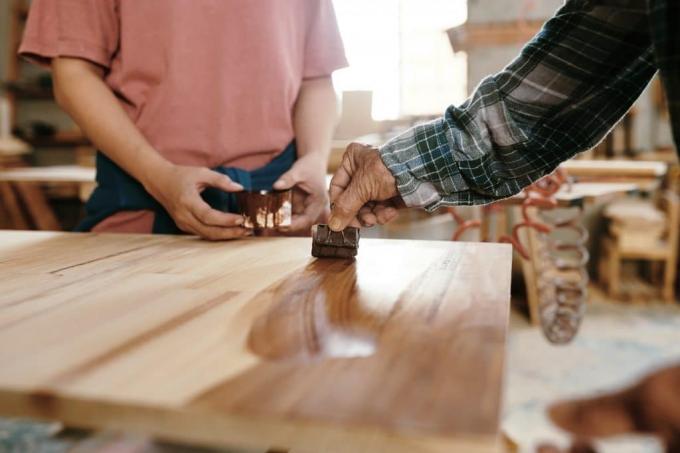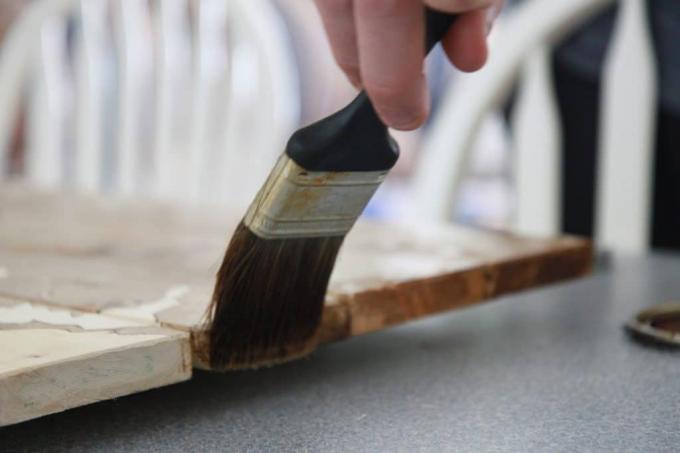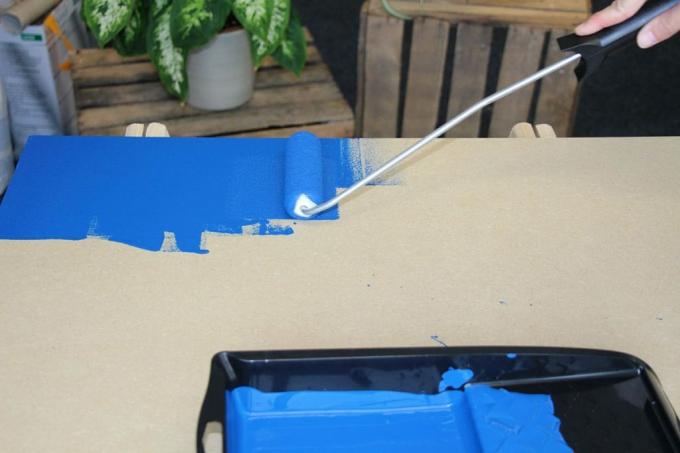
table of contents
- Oil
- Apply oil
- Glaze
- Thin layer glaze
- Middle layer glaze
- Apply glaze
- paint
- frequently asked Questions
Wooden garden furniture exudes a natural flair. In order to keep this and not turn gray, however, the furniture needs regular care, which the Protects wooden furniture from the elements.
In a nutshell
- Garden furniture needs protection from the elements
- Oiling is considered to be the most natural and easiest method
- The amount of work involved in glazing depends on the product
Oil
The prerequisite for oiling garden furniture is that the wood is untreated. Therefore, only furniture that has already been oiled or furniture made of bare wood can be considered for this care. Sand lacquered or varnished wooden furniture before treating it with oil.
Apply oil
When oiling garden furniture, the first oiling is crucial. That is why you should sand down your wooden furniture before oiling it for the first time so that the surface is nice and smooth. Then you can oil the wood. To apply the wood oil, you can
- an old, lint-free cotton or linen cloth (for example bed sheets or T-shirts) or
- a brush
use. With wood oil, you just have to make sure that it is suitable for outside. Once everything is ready, you can treat the furniture with the oil:
- Apply oil generously (the garden furniture looks damp after oiling)
- Let it soak in for 15 to 25 minutes
- Thoroughly wipe off any excess wood oil with a clean, lint-free cloth
- let dry overnight
- Treat wooden furniture again with less oil

Tip: In the following years the work is reduced. You then only need to wipe the garden furniture with a slightly oily cloth.
Advantages and disadvantages of wood oil
- Preservation and reinforcement of the grain
- Wood remains breathable (moisture can escape)
- penetrates deep (prevents cracking)
- does not peel off
- protects against dehydration and premature graying
- Wooden furniture feels natural
- Disadvantage: refresh annually
Glaze
When glazing is between
- Thin layer glazes,
- Middle layer glazes and
- Thick layer glazes
differentiated. The strength of the glaze applied depends primarily on how exposed your garden furniture is to the weather. As a result, there are other differences between thin and medium-layer glaze.

Thin layer glaze
- Primer not necessarily necessary
- low viscosity (drips during processing)
- penetrate deep into the wood
- natural grain is retained
- Wood feels natural
- Diffusibility is retained
- lasts up to four years depending on the weather
- can be painted over after simple cleaning (brushing off or soapy water)
Middle layer glaze
- Priming necessary
- fewer drops when processing
- less natural feel
- lower diffusibility
- lasts up to seven years
- should not peel off (pay attention to the quality of the product)
- can easily be painted over
Apply glaze
Remove all dirt particles from the patio furniture before applying the glaze. If part of the glaze has peeled off, it must be completely sanded off. Then the wood must be freed from the sanding dust and dry well. A primer is always necessary for coniferous wood.
- Apply evenly in the direction of the grain
- Immediately catch the drops with the brush and spread them on
- possibly. Let dry overnight and glaze a second time (depending on the product)
Note: Glaze stains are extremely difficult to remove. Therefore, you should cover the floor well.
Advantages and disadvantages of a glaze
The advantage of glazing is that your garden furniture is protected longer than with oiling. However, if cracks form in the glaze, the protective layer must be renewed because the wood is no longer protected in these areas. With some products, the wood has to be sanded again before the second application, which means more work.
paint
For the painting of garden furniture, only an exterior paint is possible. Clean the wood beforehand. A primer is necessary to ensure that the paint adheres well. This must be applied in several layers, whereby the previous one must be well dried. For the actual painting, three coats are necessary:
- Primer
- Intermediate coat
- Top coat

The paint must be completely dry between coats. The application of a protective layer or a seal may also be necessary, but does not have to be.
Advantages and disadvantages of painting
Of the treatments described, painting is considered the longest protection. However, if the paint flakes off, the wood is no longer protected. In this case, the old paint layer must be removed and then repainted. The wood grain is also no longer visible after painting. In addition, the feel of the wooden furniture is lost.
frequently asked Questions
Yes, you can oil lacquered furniture. Since the lacquer completely covers the wood surface, the oil cannot penetrate and therefore has no protective effect.
It is controversial whether oils are better for specific types of wood. The universal oil for all types of wood is hard oil. If you want the oil to have a slight tint, you should use special oils if necessary.
Since the thin-layer glaze is prevented from penetrating the wood by the middle layer, the protection is lost. However, it is possible to apply a middle-layer glaze to a thin-layer glaze if you want to change the glaze.



